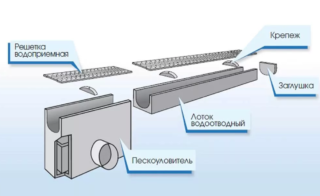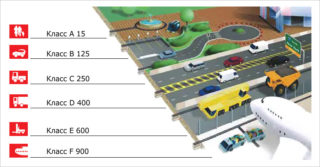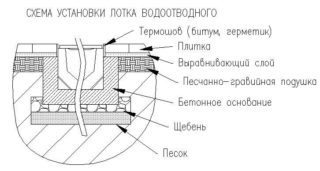Storm sewerage - communication to remove excess rain / melt precipitation from hard surfaces. The main element of the system is the gutter. It may differ in material of manufacture and dimensions, but it performs one function - transporting wastewater to a city receiver or a private septic tank.
Definition and purpose of drainage trays
Use gutters for the following purposes:
- open drainage of wastewater from concrete surfaces: foundation, blind area, garden paths;
- removal of rain or melt water from highways and city / suburban roads;
- diversion of industrial effluents;
- collection and transportation of water from car washes, gas stations, runways.
In some cases, concrete gutters can be used as cable ducts. Such products are not used as a drainage system in the ground. Here, special perforated pipes made of fiberglass or other elastic material are needed.
Types and device
There are two types of gutters: horizontal and vertical.
According to the load on the gutters, the following types are distinguished:
- A 15. Withstand dynamic load up to 15 tons. Such gutters are laid in pedestrian zones, on bicycle paths, in the garden of a private house.
- B 125. Maximum load up to 12.5 tons. They are laid in parking lots and in areas of city roads.
- From 250. Load up to 25 tons. They are laid in large car washes, in a car service, at a gas station.
- D 400. Withstand loads up to 40 tons. They are more often used for the installation of storm sewers on highways, highways, in large industrial enterprises.
- E 600. Maximum load level - 60 tons. They are installed in the area of logistics centers, large warehouses. In this class, PPK "Apatek", ecological, "Biolot" gutters are manufactured.
- F 900. Load class up to 90 tons. Trays are used for the installation of hydraulic storm drains at airports and military bases.
Manufacturing materials

Road drainage trays are made of durable materials. The most popular are concrete, polymer, composite.
Concrete gutters
Products are classified as E600 and F900. Made by vibropress method. As a result, monolithic trays have a number of advantages:
- high resistance to mechanical stress;
- inertness to moisture and aggressive environments;
- lack of corrosion;
- resistance to temperature fluctuations;
- durability (50 years or more).
The disadvantage of concrete is the weight of the products. To lay the gutters, it is necessary to use special equipment, which is expensive. Because of this, trays are not used in private construction of reinforced concrete products.
Composites (polymer concrete and polymer sand mixture)
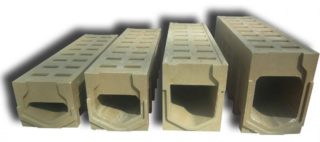
Polymer concrete trays are produced with the inclusion of special resins in the solution. They make the final product more plastic and lightweight. With concrete strength, the tray can be laid without the use of special equipment. In addition, polymer concrete gutters have a smoother inner surface, which prevents siltation of the drainage system.
For the production of polymer sand (composite) products, the pressing technique is used. The mixture consists of quartz sand and polymer chips. The resulting tray has the following positive characteristics:
- high strength and inertia to shock loads;
- resistance to aggressive environments;
- low level of water absorption;
- low weight and the ability to work alone when laying sewers;
- favorable cost;
- environmental friendliness of products.
Polymer sand trays have a strength class of C250, therefore they are not suitable for laying on large-scale objects with high loads.
Polymers (plastic)
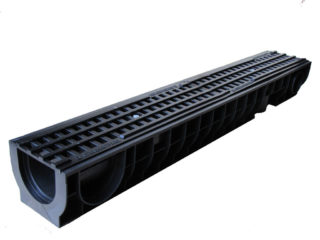
Trays of class A, B, C are produced from HDPE and polypropylene. They are ideal for private construction. Plastic gutters have special stiffening ribs, which prevents them from breaking even in heaving soil. The advantages of such products include:
- high strength;
- resistance to temperature extremes;
- inertness to chemical inclusions;
- wear resistance;
- long service life;
- ease of installation (plastic is easy to cut and fit).
For laying stormwater in a private house, it is better to use polymer gutters.
Dimensions of trays
Reinforced concrete rainwater gutters have a length of 500 to 3000 mm. In rare cases, it is possible to manufacture trays from concrete 6 m long. In this case, the internal hydraulic section varies in the range of 100-500 mm. The width of the gutters ranges from 400-1900 mm.
The length of one section of the polymeric drainage tray is 1-2 meters. The inner diameter ranges from 60-311 mm.
Metal (cast iron) trays are used extremely rarely due to their high cost and huge mass.
Criterias of choice
Going for the gutters, you should take into account the following nuances:
- Capacity and load class of the product.
- Manufacturing material. The process of transportation and the complexity of laying the sewerage depend on it.
- Quality of joints and grooves. They ensure the tightness of the final communication.
- Factory bias. It is extremely important if it is not possible to create a slope when digging trenches due to the characteristics of the soil or relief on the site.
When buying, you should pay attention to the grill. It is desirable that it has a locking mechanism if the system will be mounted in public places.
Installation rules
- Prepare a trench for the installation of stormwater. It is immediately made with a bias towards the receiver. In this case, the depth and width of the channel is increased by 15-20 cm based on the further strengthening of the gutters.
- The bottom of the trench is well tamped and covered with sand with a layer of 10 cm. It is slightly moistened and also compacted.
- A concrete solution is poured onto a sand cushion. It will serve as the base for the trays. For greater strength, the fill can be reinforced.
- Once the concrete is dry, you can start laying the gutters. They are carefully joined together. Seals are used in polymer trays. For concrete channels, bituminous or acrylic mastics are used.
- As soon as the trays are laid, you can mount a special mesh along their edges outside and pour the gutters from the side of the ground with a concrete mixture. It will act as a limiting factor for possible heaving of the soil.
- The last thing to do is to install protective grilles. In this case, it is important to ensure that they are located slightly below the site from which rainwater will be drained.
It is better to lay the trays along the control thread. So the flatness of the channel will be perfect.
The cost of water drainage trays
The price of trays for storm sewers varies depending on the material of their manufacture, length, section, width, load and manufacturer, region of Russia. Average cost of storm gutters:
| Tray name | Section length | Internal section | Price, rub.) |
| Polymer drainage tray Standart | 1000 mm | 60 mm | RUB 290 |
| Drainage tray Standart | 1000 mm | 160 mm | 440 RUB |
| Polymer gutter Standart | 2000 mm | 200 mm | 720 RUB |
| Polymer tray Max with cast iron lattice | 1500 mm | 220 mm | RUB 1100 |
| Polymer drainage gutter with cast iron grate | 2000 mm | 101 mm | 1200 RUB |
| Concrete tray Standart with cast iron grating | 1000 mm | 140 mm | RUB 930 |
| Concrete gutter Standart with galvanized grating | 1000 mm | 140 mm | 1660 RUB |
| Concrete tray Standart with cast iron grating | 1000 mm | 165 mm | 1670 RUB |
| Polymer concrete gutter | 1000 mm | 140 mm | RUB 870 |
| Reinforced concrete tray drainage LAN | 1000 mm | 300 mm | RUB 840 |
| Concrete drainage channel Standartpark | 1000 mm | 140 mm | 370 rbl. |
| Ecolot composite tray for Russian Railways | 4080 mm | 500 mm | RUB 8,500 / running meter |
| Composite gutters "Biolot" | 2480 mm | 750 mm | RUB 9500 / running meter |
| Composite tray Ecolot | 2080 mm | 1000 mm | 9000 rub / running meter |
The price list shows the prices for the most popular types of gutters. This will help to roughly calculate the total cost of the storm sewer installation. High-quality drainage of water from the building allows you to extend its operation.

